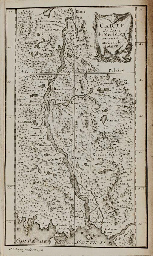GELLIBRAND, Henry (1597-1636). A Discourse Mathematical on the Variation of the Magneticall Needle. Together with Its admirable Diminution lately discovered . London: William Jones 1635.
GELLIBRAND, Henry (1597-1636). A Discourse Mathematical on the Variation of the Magneticall Needle. Together with Its admirable Diminution lately discovered . London: William Jones 1635. 8 o (183 x 107 mm). (Closely trimmed with loss of some headlines and shoulder notes, some browning and pale spotting.) Rembôitage in near contemporary limp vellum binding; red quarter morocco folding case. FIRST EDITION OF GELLIBRAND'S MOST IMPORTANT DISCOVERY: THE CHANGE IN MAGNETIC DECLINATION, OR VARIATION. Gellibrand, professor of astronomy at Gresham College, advanced the idea of finding variation of the compass by the amplitude of the sun. He based his ideas on the magnetic theories of William Gilbert, agreeing with Gilbert's theory that midway between continents the variation in declination should be nil and that the needle should be drawn to one side or the other as the ship approached one of the continents. His main contribution was to show that there was a variation in the variation: "Thus hitherto (according to the Tenents of all our Magneticall Philosophers) we have supposed the variations of all particular places to continue one and the same. So that when a seaman shall happly returne to a place where formerly he found the same variation he may hence conclude he is in the same former longitude" (p.6). Observations were carried out for years to test the accuracy of Gellibrand's observations and they were proved correct. As for the method of determining position, the advantage of Gellibrand's method was that only one observation was necessary and that opportunities for taking the measurement were offered twice every day in any latitude where the sun rose and set. The finding of the sun's true bearing at sunrise and sunset depended on a simple trigonometrical calculation which had been made possible by the recently published trigonometric tables of John Napier and Henry Briggs. (See lots 70 and 379.) The method became very popular by the end of the seventeenth century. See Commander J.B. Hewson, A History of the Practice of Navigation , Glasgow, 1963, pp. 127, 135-6. VERY RARE: according to American Book Prices Current , no copies have sold in at least 30 years. Adams & Waters 1156; STC 11712; Taylor Mathematical Practitioners 162-3.
GELLIBRAND, Henry (1597-1636). A Discourse Mathematical on the Variation of the Magneticall Needle. Together with Its admirable Diminution lately discovered . London: William Jones 1635.
GELLIBRAND, Henry (1597-1636). A Discourse Mathematical on the Variation of the Magneticall Needle. Together with Its admirable Diminution lately discovered . London: William Jones 1635. 8 o (183 x 107 mm). (Closely trimmed with loss of some headlines and shoulder notes, some browning and pale spotting.) Rembôitage in near contemporary limp vellum binding; red quarter morocco folding case. FIRST EDITION OF GELLIBRAND'S MOST IMPORTANT DISCOVERY: THE CHANGE IN MAGNETIC DECLINATION, OR VARIATION. Gellibrand, professor of astronomy at Gresham College, advanced the idea of finding variation of the compass by the amplitude of the sun. He based his ideas on the magnetic theories of William Gilbert, agreeing with Gilbert's theory that midway between continents the variation in declination should be nil and that the needle should be drawn to one side or the other as the ship approached one of the continents. His main contribution was to show that there was a variation in the variation: "Thus hitherto (according to the Tenents of all our Magneticall Philosophers) we have supposed the variations of all particular places to continue one and the same. So that when a seaman shall happly returne to a place where formerly he found the same variation he may hence conclude he is in the same former longitude" (p.6). Observations were carried out for years to test the accuracy of Gellibrand's observations and they were proved correct. As for the method of determining position, the advantage of Gellibrand's method was that only one observation was necessary and that opportunities for taking the measurement were offered twice every day in any latitude where the sun rose and set. The finding of the sun's true bearing at sunrise and sunset depended on a simple trigonometrical calculation which had been made possible by the recently published trigonometric tables of John Napier and Henry Briggs. (See lots 70 and 379.) The method became very popular by the end of the seventeenth century. See Commander J.B. Hewson, A History of the Practice of Navigation , Glasgow, 1963, pp. 127, 135-6. VERY RARE: according to American Book Prices Current , no copies have sold in at least 30 years. Adams & Waters 1156; STC 11712; Taylor Mathematical Practitioners 162-3.















Testen Sie LotSearch und seine Premium-Features 7 Tage - ohne Kosten!
Lassen Sie sich automatisch über neue Objekte in kommenden Auktionen benachrichtigen.
Suchauftrag anlegen